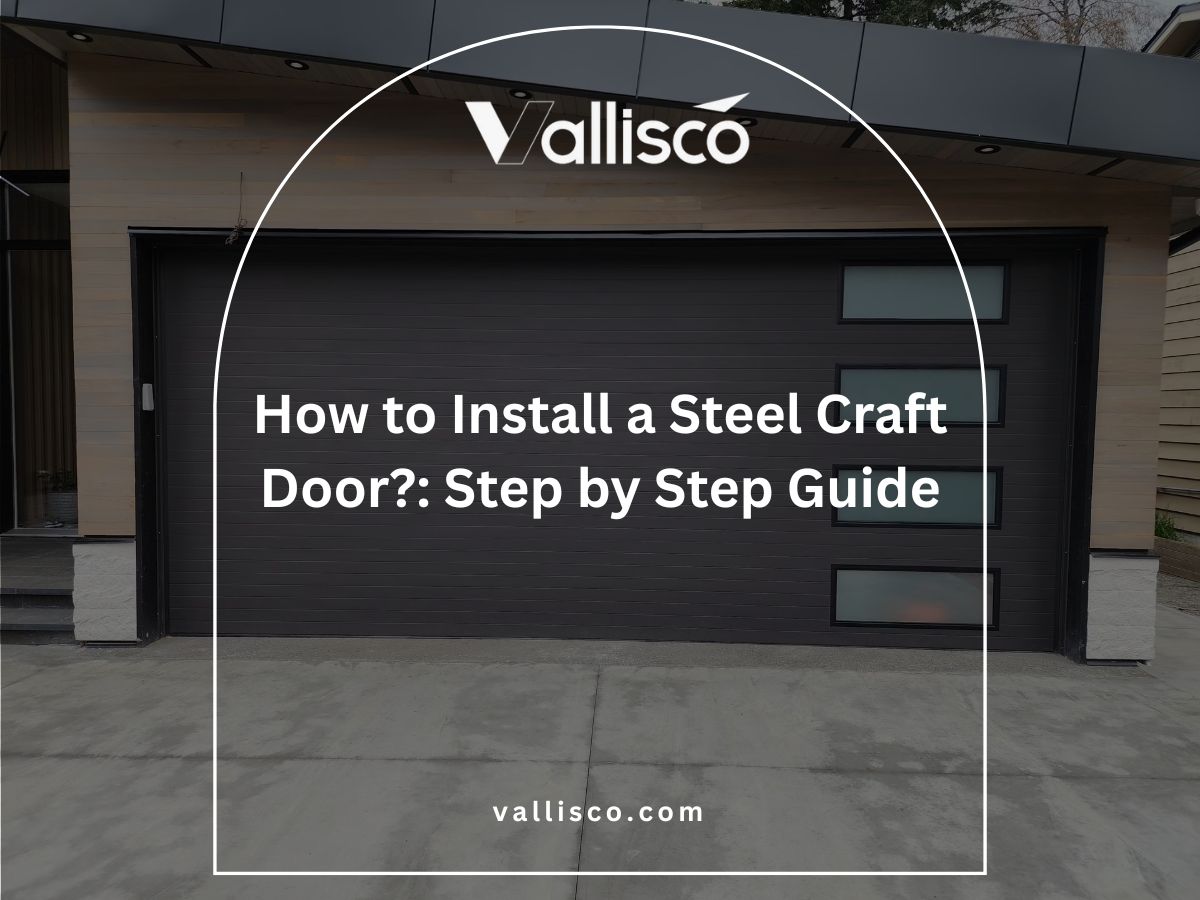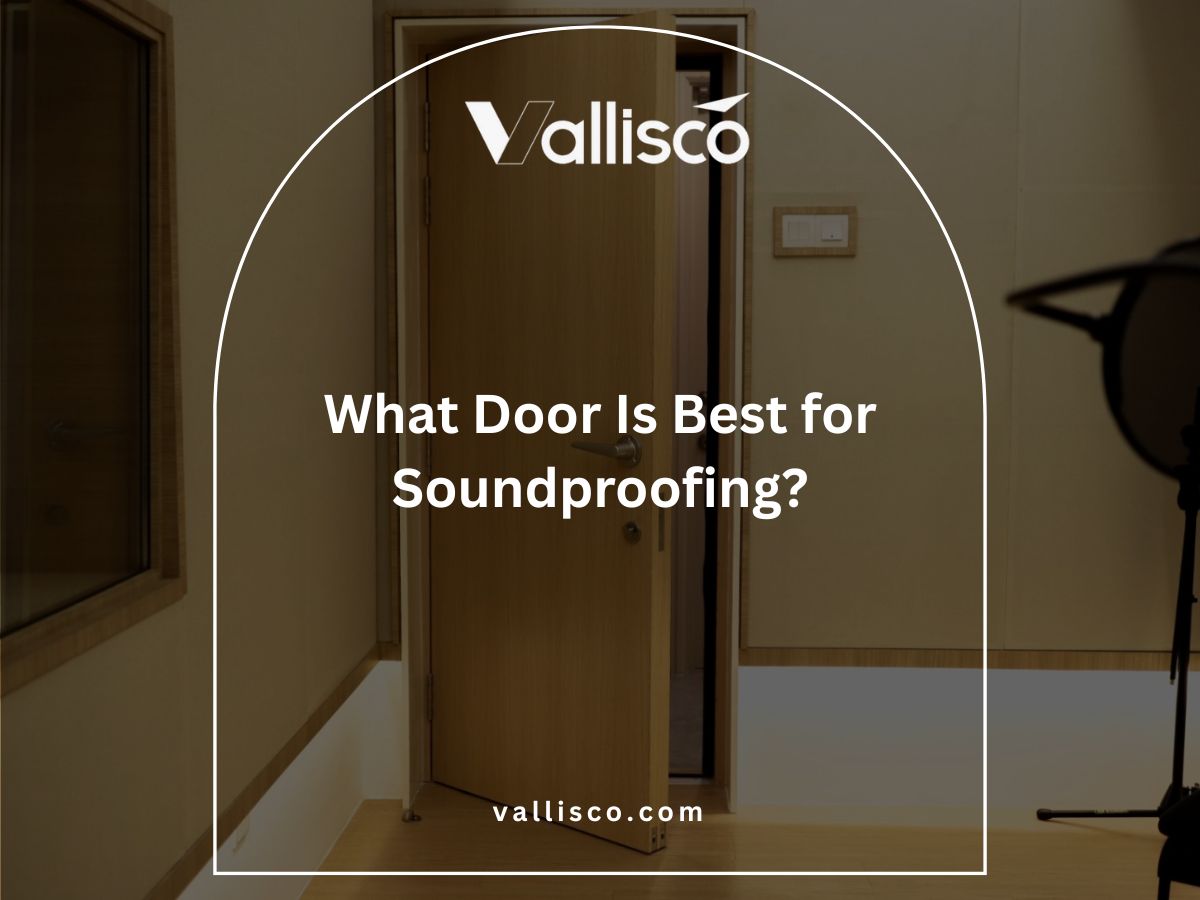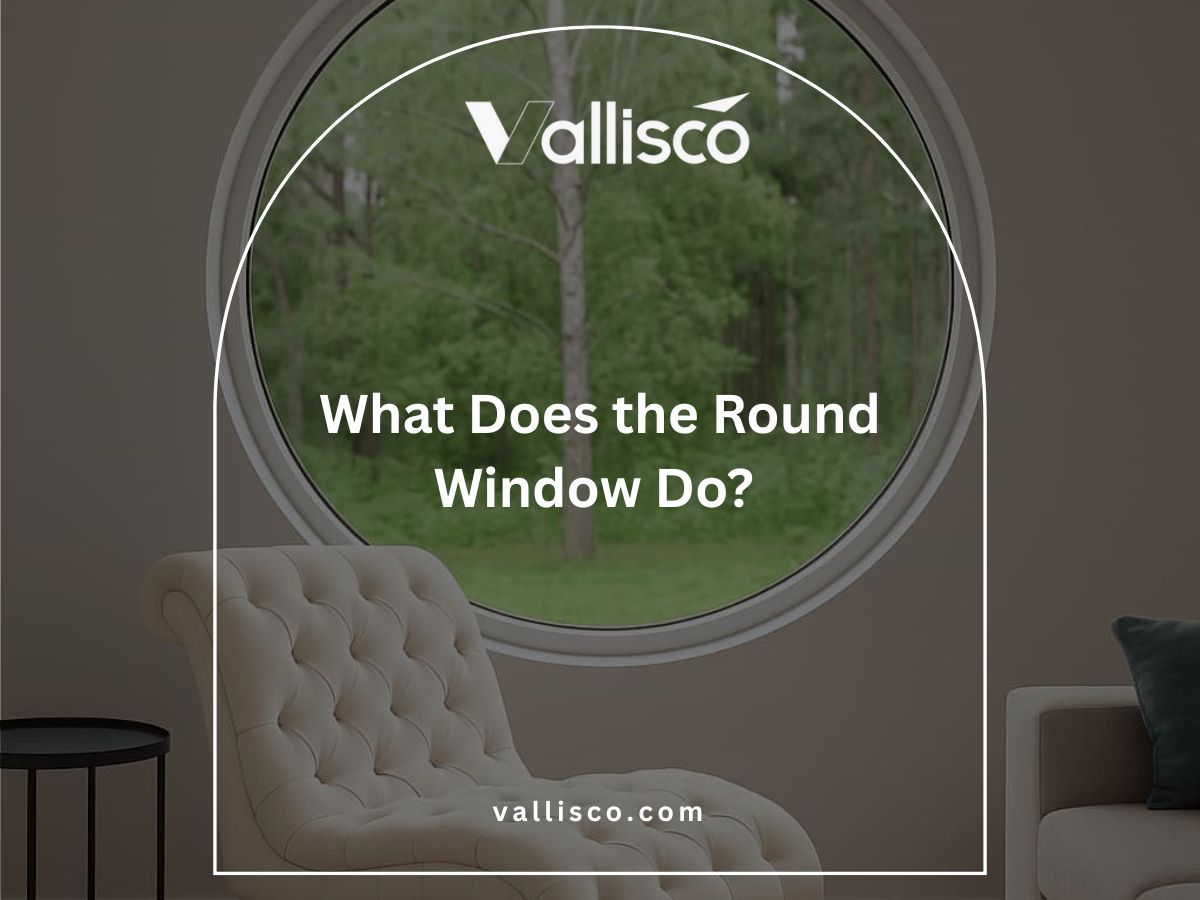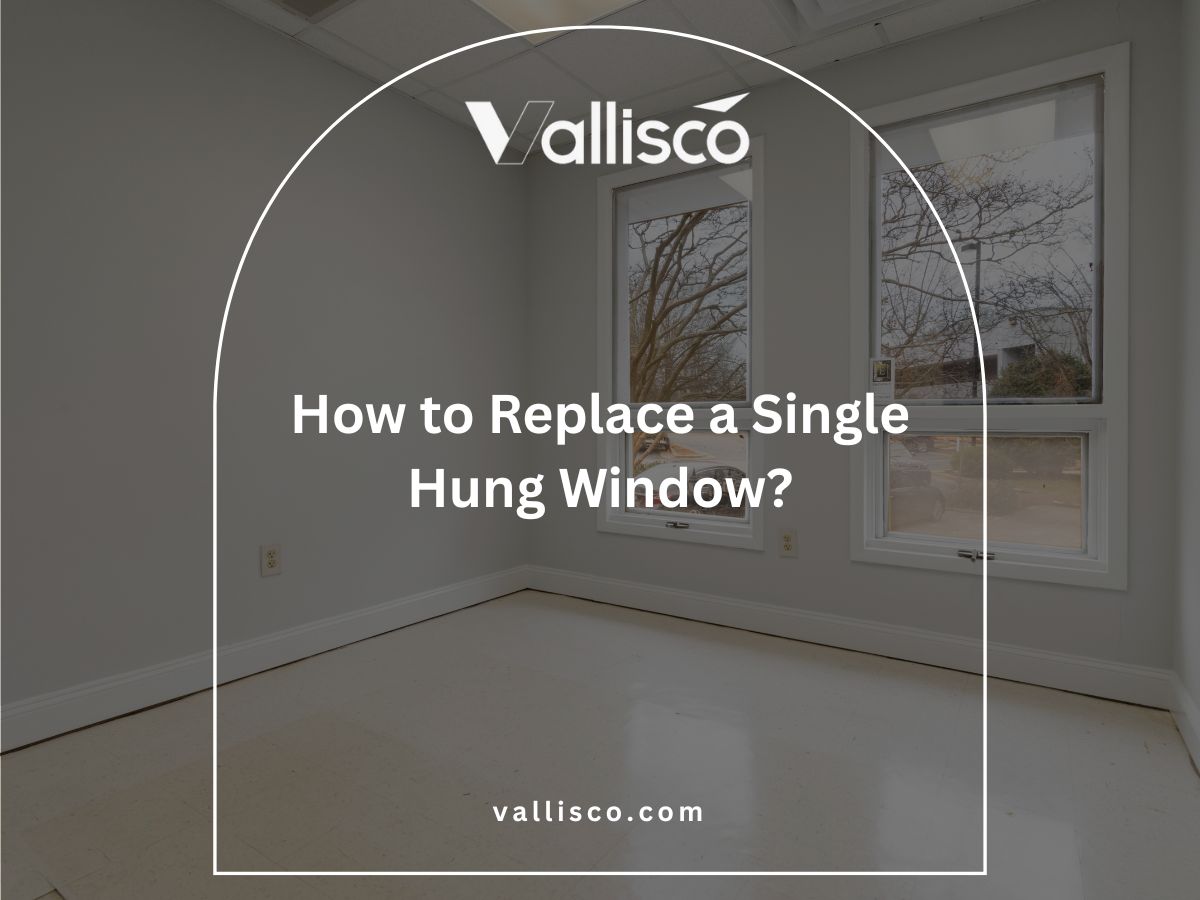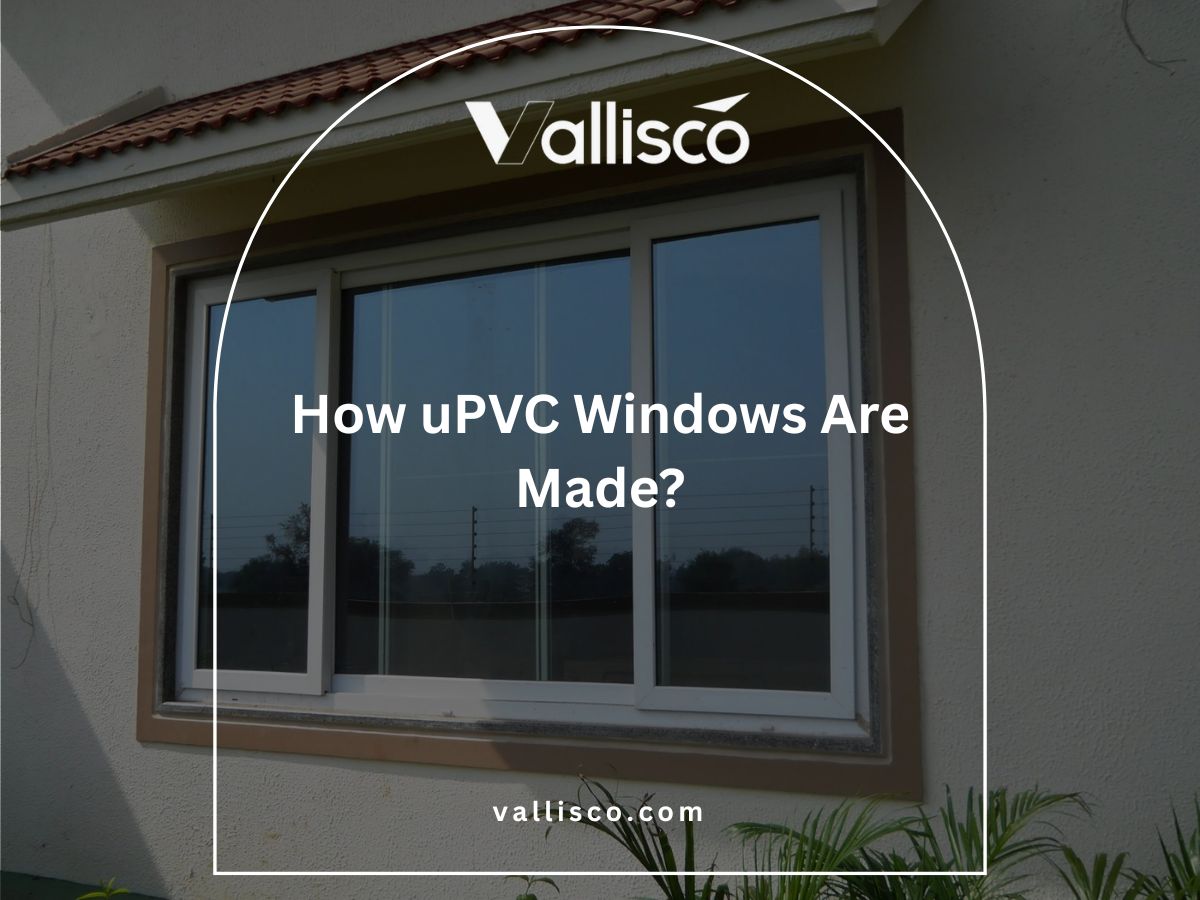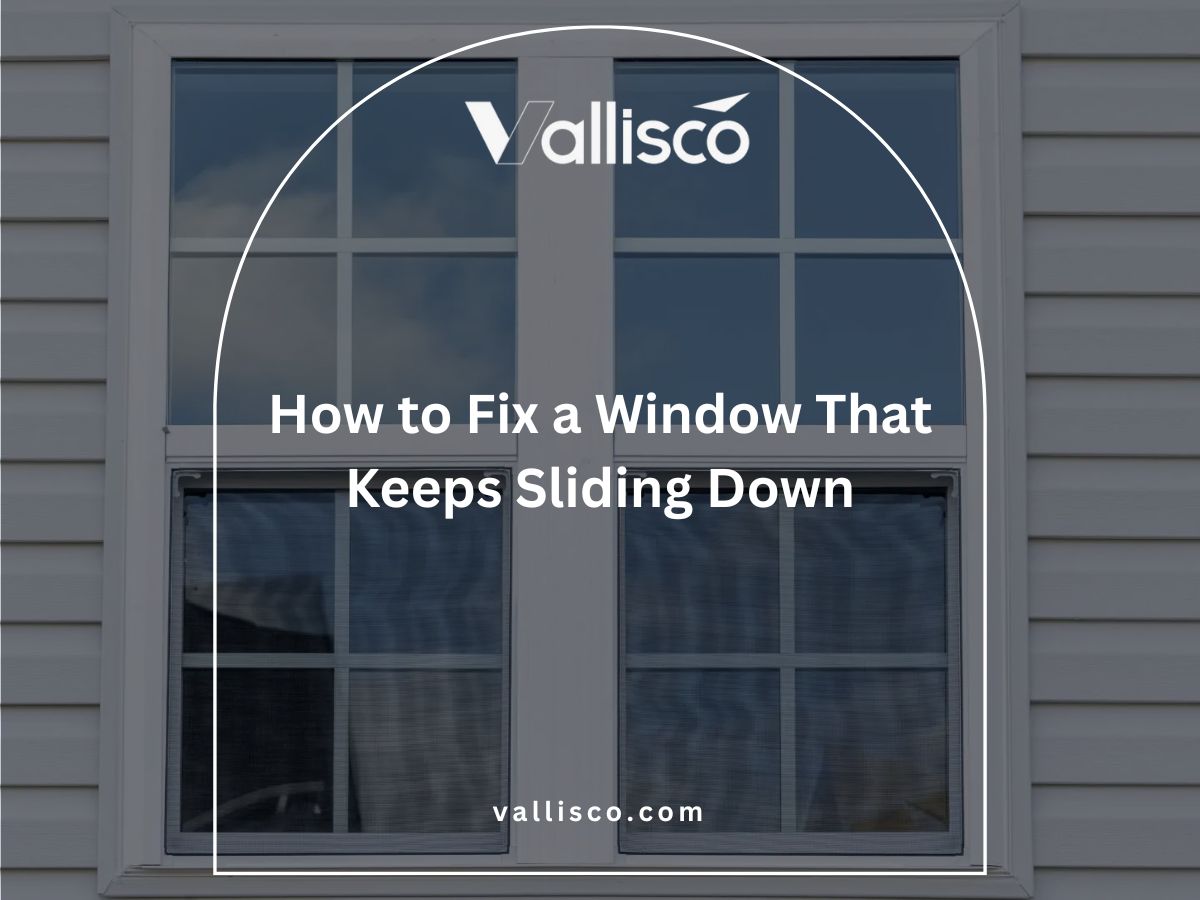The first time I installed a pocket sliding door in a small apartment, the owner said it felt like a wall disappeared.
That stuck with me and shaped how I now look at sliding door solutions for limited spaces.
Over the years, I’ve helped many project teams improve room layouts by switching to the right sliding doors. My feedback comes from real-site results, not guesswork.
This article shares 8 sliding door styles that perform well in apartments. By the end, you’ll have a clear idea of which one fits your needs.
If space is tight and function matters, this list will save you time and trouble.
So, let’s get started!
Quick Comparison Chart
Before we explore each sliding door style in detail, here’s a quick comparison to give you a high-level view. This table will help you spot key differences before digging into the specifics.
| Sliding Door Style | Best For | Key Feature Highlight | Common Limitation |
| Glass Panel | Light-sharing dividers | Clean, open look | Low privacy |
| Frosted Glass | Soft privacy zones | Blurs view, soft light | Limited sound control |
| Barn-Style | Statement wall openings | Rustic full coverage | Needs wall space |
| Tight walkways | Hidden in wall | Requires early planning | |
| Mirror Closet | Bedroom closets | Doubles as mirror | Shows smudges |
| Wooden Panel | Warm living spaces | Solid wood finish | Sensitive to humidity |
| Aluminum Frame | High-use modern units | Slim and durable | Less sound blocking |
| Bypass | Closets with no swing room | Slides past panels | Partial access only |
You’ve got the snapshot, now we’ll walk through the specifics of each style in the following sections.
1. Glass Panel Sliding Doors
I’ve used glass panel sliding doors in a few apartment projects where space felt tight but needed a better flow. They work great when you want separation without making rooms feel boxed in. If your unit has a balcony, kitchen divider, or compact layout, this is one style worth considering.
Features
- Modern Look: Glass panel doors give apartments a clean, updated appearance that fits well with minimalist or contemporary interiors. They often help elevate the perceived value of space.
- Visual Continuity: These doors let you divide areas without breaking up the line of sight, which helps maintain a more open layout in tight floor plans.
- Easy Cleaning: A quick wipe-down with glass cleaner keeps them looking good. There’s no paint or sealant maintenance like wood doors.
- Customizable Frames: You can choose aluminum, wood, or powder-coated steel frames based on the look and durability your project calls for.
Installation Tips
- Check Load Capacity: Make sure the ceiling or wall can support the track system, especially if using heavier framed glass panels.
- Align Tracks Carefully: Even small shifts during installation can cause sliding issues later. Double-check leveling before anchoring.
- Pre-Plan Electrical and Lighting: Since these doors are transparent, anything behind them will be visible. Plan outlet and switch placements accordingly.
Final Thoughts
Glass panel sliding doors are best for projects focused on visual openness and a more polished interior. But if your client needs more privacy or sound control, other options might be a better fit.
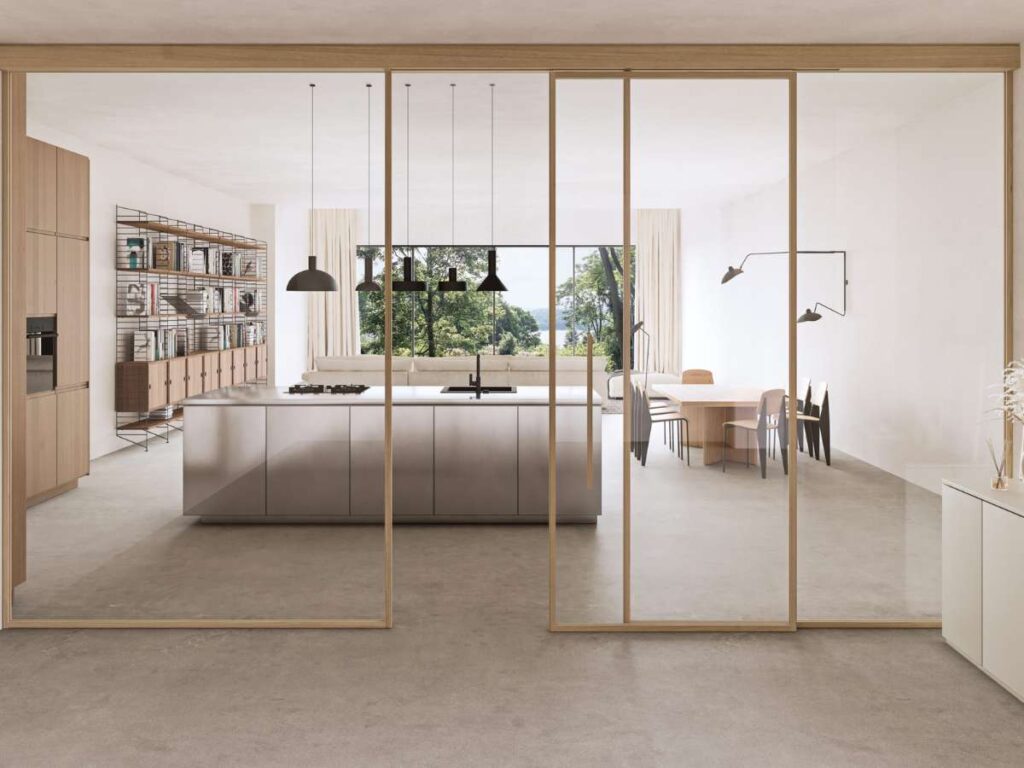
2. Frosted Glass Sliding Doors
Frosted glass sliding doors use a semi-opaque surface that blurs visibility while still allowing soft light to pass through. These are often used to create private spaces without making the area feel closed off. I’ve seen them used successfully in apartments, boutique hotels, and shared living areas where both privacy and light matter.
Features
- Privacy with Light Control: The frosted surface limits visibility without completely blocking daylight, making it ideal for bathrooms, closets, or between bedrooms and hallways.
- Neutral Design Fit: Its subtle look pairs well with wood, tile, or concrete finishes, which helps when you’re coordinating across different materials.
- No Direct Reflection: Unlike clear glass, frosted panels don’t bounce back sharp reflections, making them less distracting in brightly lit rooms.
- Scratch-Resistant Options: Many frosted glass doors now come with treated surfaces that hold up well over time, even in high-traffic apartments.
Installation Tips
- Keep Protective Film On Until Final Step: This reduces the risk of marking the surface during transport or installation, I’ve had one install where a small scratch stood out once the light hit it.
- Choose the Right Track Style: Wall-mounted tracks often work better than ceiling tracks in retrofits or renovations where overhead structure is limited.
- Double-Check Glass Thickness: Not all frosted panels are made the same. Thicker panels give better stability and help prevent rattle over time.
Final Thoughts
Frosted glass sliding doors are best for places where you want partial privacy without making a room feel dark. However, they don’t completely block sound and may not suit projects needing full separation between zones.
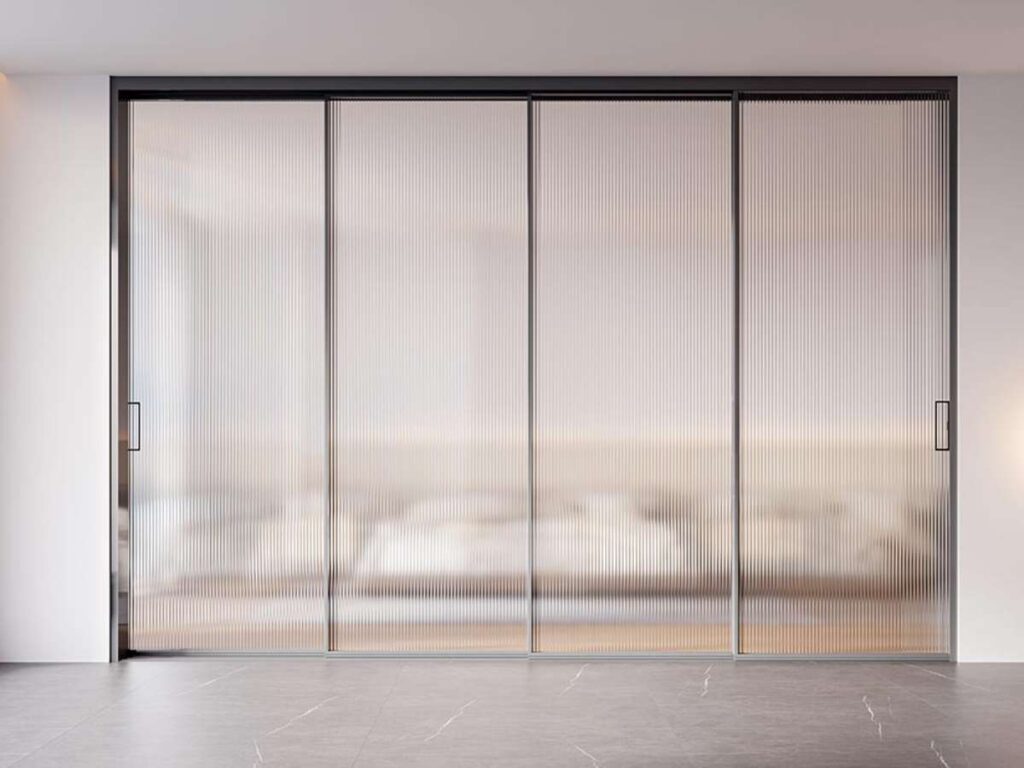
3. Barn-Style Sliding Doors
Barn-style sliding doors are solid panel doors that hang from a visible top-mounted track and slide along the wall surface. They’re often made of wood or metal and give spaces a more distinctive or rustic look. I’ve noticed many apartment projects use them to add character without sacrificing floor space.
Features
- Exposed Track Hardware: The visible rollers and rails add a design element that fits industrial or rustic interiors. It’s a style choice as much as a functional one.
- Full Panel Coverage: These doors fully cover the opening, which is useful when you want to block off noise or visual clutter between rooms.
- Material Flexibility: You can use reclaimed wood, painted panels, or even steel sheets to match the building’s overall finish.
- Easy to Modify or Refinish: One client of mine repainted their barn door after a few years to match a new color scheme, no special tools needed.
Installation Tips
- Check Wall Clearance: These doors slide along the outside of the wall, so make sure there are no switches, outlets, or trim in the way.
- Use a Backer Board if Needed: In apartments with drywall-only construction, a backer board helps distribute weight and reduces wall damage.
- Secure the Floor Guide: Even though the track is on top, a bottom floor guide keeps the door from swinging or wobbling, especially in high-use areas.
Final Thoughts
Barn-style sliding doors are best if you’re aiming for visual impact with practical function. But they need enough wall space to slide open fully and may not work well in narrow hallways.
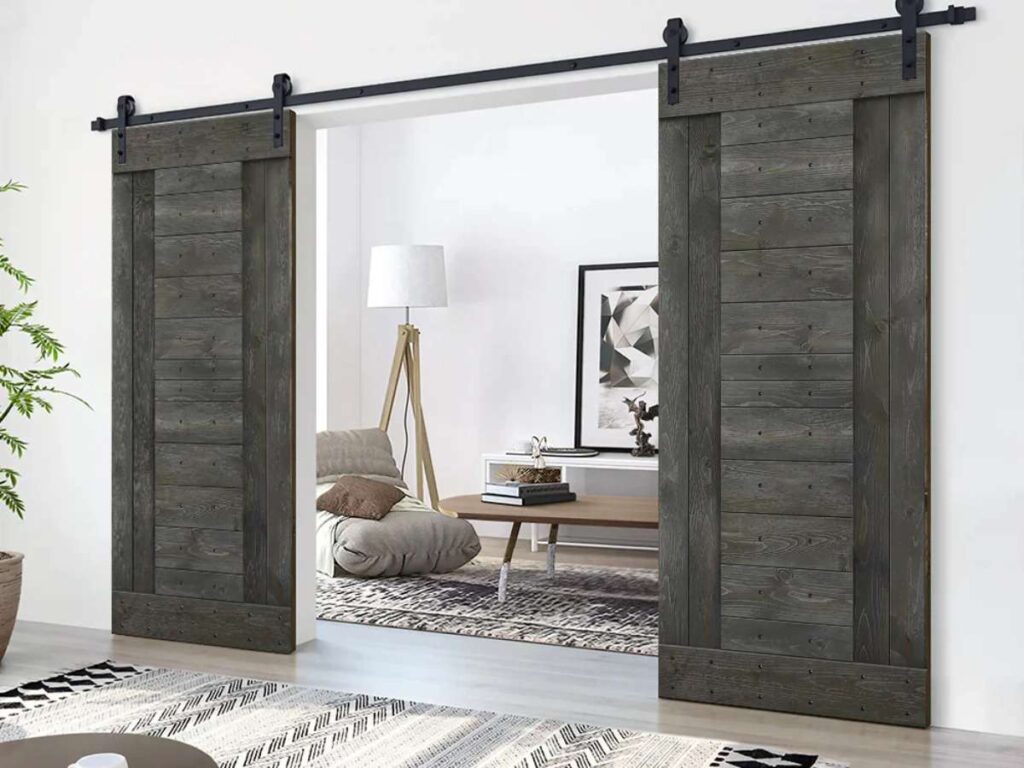
4. Pocket Sliding Doors
Pocket sliding doors are designed to slide into a hidden cavity inside the wall, leaving no door visible when open. They’re great for small apartments or areas where a traditional swinging or wall-mounted door just won’t fit. I’ve recommended them more than once for tight guest rooms or compact kitchen entries.
Features
- Space-Saving Function: Since the door disappears into the wall, it frees up both sides of the opening for furniture or fixtures. Vallisco is known for building pocket door systems that glide smoothly, fit tight framing, and hold up well under daily use.
- Flush Finish When Open: These doors leave no surface track or panel exposed, creating a seamless transition between rooms.
- Good for Tight Doorways: Ideal in places where wall-mounted barn or bypass doors would take up valuable clearance.
- Can Be Single or Double: Some projects I’ve worked on used double-pocket doors for wider openings, especially in suites or apartment lounges.
Installation Tips
- Plan Ahead for Wall Cavity: Pocket doors need a clear space inside the wall. Avoid running plumbing or electrical lines through this area.
- Use a Solid Frame Kit: Reinforced kits help prevent flexing or warping over time, which is especially important in multi-unit buildings.
- Install Soft-Close Mechanism: Helps prevent slamming and extends the life of the door, especially in high-traffic or rental units.
Final Thoughts
Pocket sliding doors are best when you need to save every inch of space and want a clean, hidden finish. However, retrofitting them into existing walls can be costly and time-consuming without early planning.
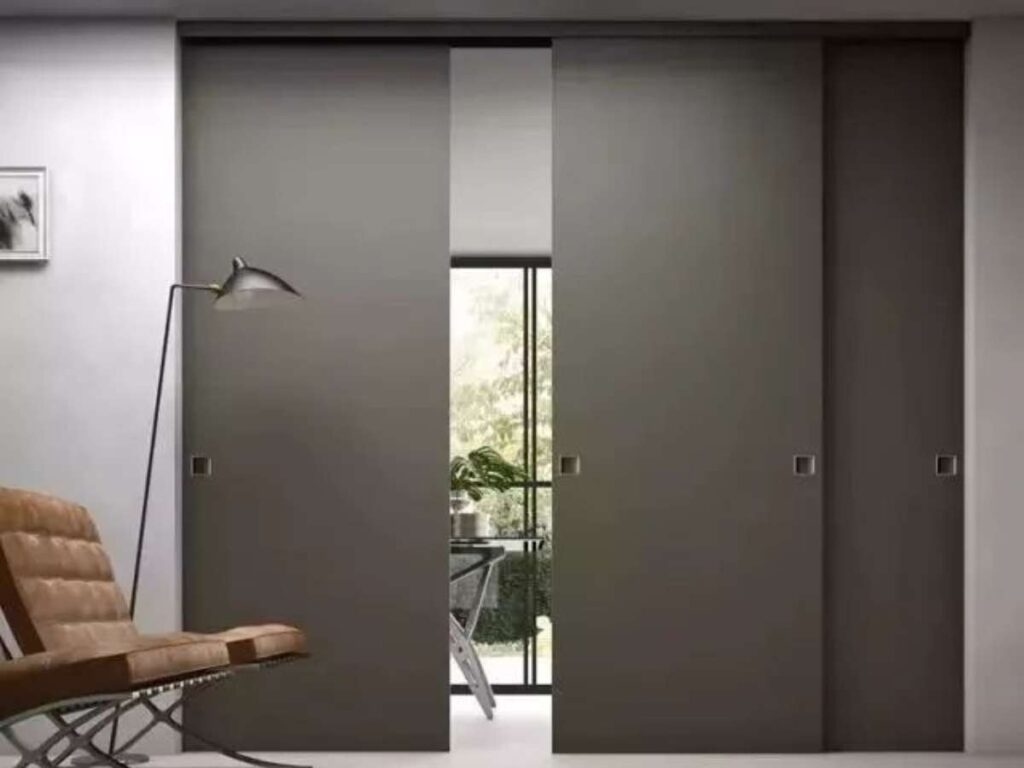
5. Mirror Sliding Closet Doors
Mirror sliding closet doors combine two functions, door and full-length mirror in one panel that slides smoothly across a track. They’re most commonly used in bedrooms and dressing areas in apartments. I’ve seen them used well in small units where tenants need both storage access and a mirror without taking up wall space.
Features
- Dual Purpose: These doors serve as both a closet cover and a built-in mirror, reducing the need for extra fixtures in the room.
- Visual Enlargement: Mirrors help reflect light and give the illusion of more space, which is especially helpful in tight bedroom layouts.
- Track or Frame Variety: You can choose from frameless, aluminum, or wood-framed versions depending on the unit’s style and maintenance needs.
- Safe Mirror Options: Many models now use shatter-resistant safety glass, and I always recommend that for apartment installs where durability matters.
Installation Tips
- Use a Level Track Base: Any unevenness in the floor will cause misalignment or drag over time. Pre-check and shim if needed.
- Add Anti-Jump Mechanisms: These clips help keep the mirror doors from popping off the track especially important for high-use or rental spaces.
- Secure Bottom Guides: Since mirrors add weight, bottom guides are key for smooth sliding and long-term stability.
Final Thoughts
Mirror sliding closet doors are best for bedroom or hallway closets where you want to add function without taking up more space. But they’re less ideal in areas with lots of direct sunlight, which can highlight fingerprints and require more frequent cleaning.
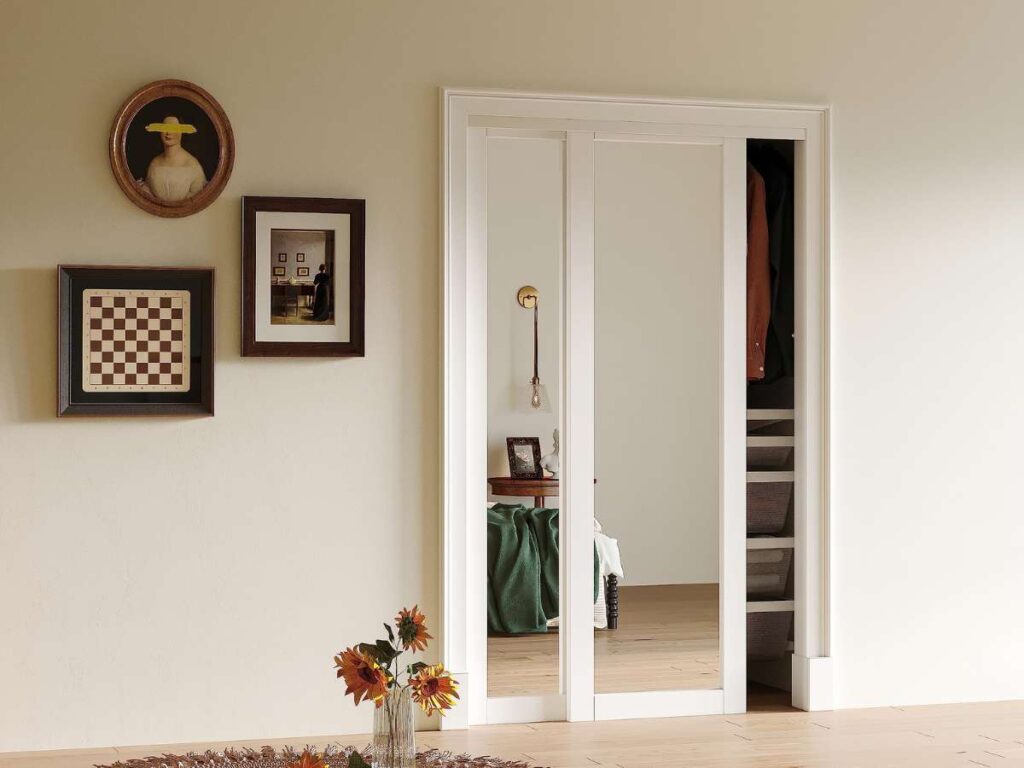
6. Wooden Panel Sliding Doors
Wooden panel sliding doors feature solid or semi-solid wood panels that slide along a track system to close off a space. They bring warmth and texture into apartment interiors, especially when used in bedrooms or living areas. I’ve worked with teams who chose them to match hardwood floors or built-in cabinetry, and the result always felt well put together.
Features
- Natural Appearance: Wood adds visual warmth and texture, making spaces feel more inviting and less sterile especially useful in units with minimalist finishes.
- Custom Finishes: These panels can be stained, painted, or laminated to match nearby furniture or trim.
- Solid Feel: Compared to glass or aluminum doors, wooden panels often slide more quietly and feel sturdier under use.
- Better Sound Damping: In my experience, thicker wooden doors help absorb sound better than other lightweight sliding options.
Installation Tips
- Use a Strong Upper Track: Solid wood adds weight, so always use a reinforced track system rated for the panel’s load.
- Seal All Edges: Especially in humid environments, sealing all sides of the panel helps prevent warping over time.
- Allow for Expansion Gaps: Wood expands and contracts slightly with changes in temperature or moisture, plan small clearances to avoid binding.
Final Thoughts
Wooden panel sliding doors are best for adding a warm, solid look to living areas or shared apartment spaces. They’re not ideal for humid zones like bathrooms unless the material is well-sealed and properly ventilated.
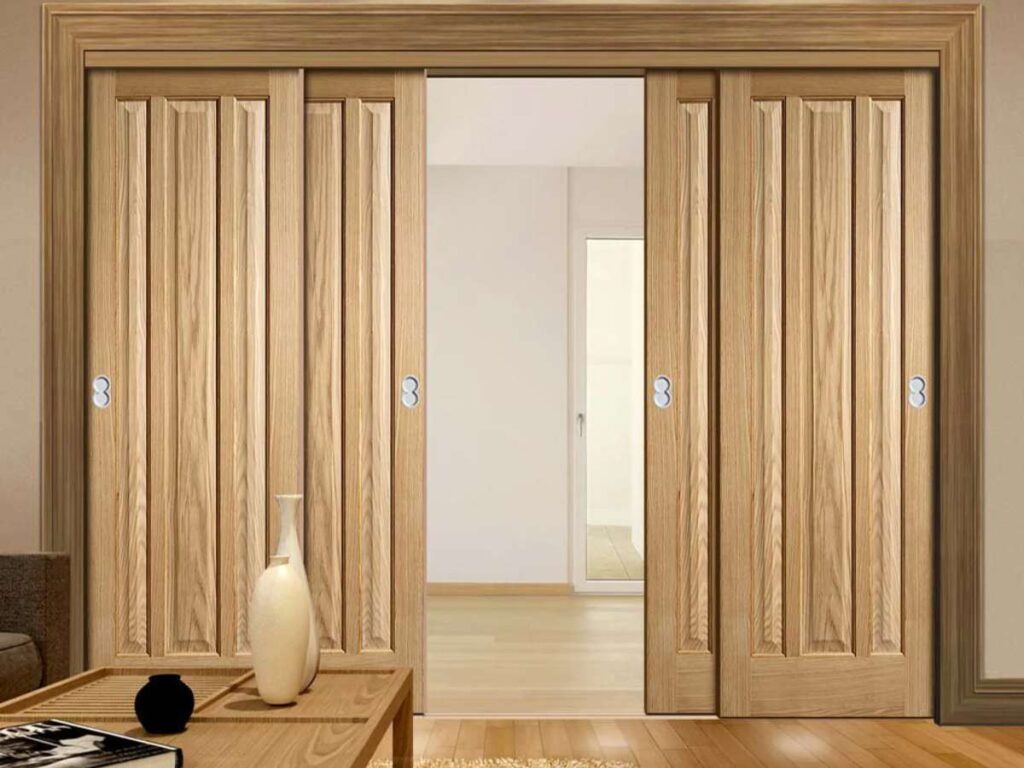
7. Aluminum Frame Sliding Doors
Aluminum frame sliding doors use slim metal frames paired with glass or other panels that move smoothly along a track. They’re popular in apartments that lean modern or industrial, especially where durability matters. I know they hold up well in multi-unit settings where doors see daily use from different tenants.
Features
- Slim Profile Frames: The narrow frame design gives these doors a clean, modern edge while maximizing the opening or viewable surface.
- Corrosion-Resistant Finish: Powder-coated or anodized aluminum holds up well in coastal or humid locations, which reduces long-term upkeep.
- Lightweight and Strong: Aluminum offers a solid structure without adding too much weight, making it easier to handle and install.
- Color Range Options: You can match frames to windows, door trims, or custom interior finishes without needing custom fabrication.
Installation Tips
- Check for Thermal Break Option: In climate-sensitive areas, using thermally broken frames can help reduce heat transfer between rooms.
- Anchor Hardware Firmly: Properly fasten all screws and brackets to prevent movement or track noise during regular use.
- Test Slide Before Final Lock-In: Check for smooth operation and full alignment before securing the door in place to avoid long-term issues.
Final Thoughts
Aluminum frame sliding doors are best for high-use areas where durability, modern looks, and minimal upkeep are important. However, they may not bring the same warmth or acoustic dampening as wood-based options.
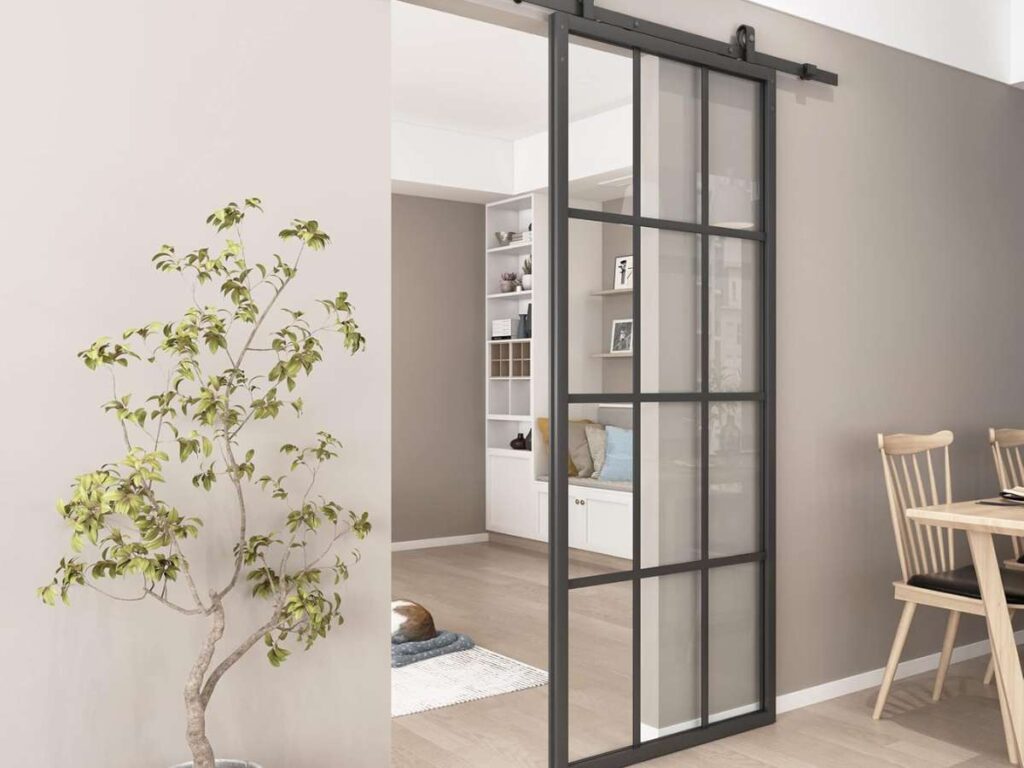
8. Bypass Sliding Doors
Bypass sliding doors are made up of two or more panels that slide past each other on parallel tracks. They’re commonly used for closets or laundry areas in apartments where space is tight and swinging doors won’t work. In one older unit I helped upgrade, switching to bypass doors gave us full access without needing extra clearance in front.
Features
- Double Track Functionality: Panels move in front of and behind each other, making them great for wide openings with limited front clearance.
- No Swing Clearance Needed: These doors slide completely within their frame, so furniture placement right in front is still possible.
- Good for Storage Areas: Often used for closets or pantries, they allow access to one side at a time without needing much wall space.
- Panel Flexibility: You can mix materials like mirrors, wood, or frosted glass to match the apartment’s design or purpose.
Installation Tips
- Ensure Proper Track Alignment: Both top and bottom tracks must be perfectly parallel to avoid sticking or uneven movement.
- Secure Bottom Guide Rails: These help keep the doors from swinging or jumping off their tracks during use.
- Test Panel Clearance: Before finalizing, slide each panel through its full range to check that they don’t rub or overlap incorrectly.
Final Thoughts
Bypass sliding doors are best for storage areas where space in front of the opening is limited but functionality is still key. But they’re less suitable for spaces where you need full access to the entire width at once, since one panel always overlaps the other.

4 Factors To Consider When Choosing The Best Sliding Door Styles for Apartments
There’s no one-size-fits-all when it comes to sliding doors in apartment projects. I’ve worked on builds where a great-looking door turned out to be the wrong fit simply because the layout wasn’t considered. If you want your door choice to last and function well, see these factors below:
#1 Wall Space and Clearance
Not every apartment layout gives you the room needed for all sliding door styles. Barn-style doors need open wall space beside the frame, while pocket doors need space inside the wall. If you’re working with narrow halls or small rooms, bypass or mirror sliding doors often fit better.
#2 Daily Use and Durability
Consider how often the door will be used. High-traffic areas in rental buildings benefit from durable materials like aluminum or laminated glass. Wood looks warm and inviting, but it needs proper sealing and ongoing upkeep, especially in multi-tenant settings.
Don’t overlook hardware quality either solid rollers and tracks can save you from frequent repairs and tenant complaints.
#3 Visual Style and Finish
The door should match the space, not clash with it. Vallisco sliding doors are cleanly built, available in multiple finishes, and designed to hold up well in real-use apartment environments. You get options that fit both modern and classic layouts without sacrificing durability.
#4 Privacy and Light Control
The right door style balances light and privacy. Clear glass can make a space feel brighter but doesn’t offer much visual separation, which may be an issue in bedrooms or shared units.
Solid panels or thicker glass are better for noise control. If you want something in between, frosted glass gives you light flow while still keeping the space private.
Conclusion
The sliding door fixed that awkward layout. It gave the space a better flow and made it easier to live in. That’s the impact a good door can have.
In this article, you’ve seen eight strong door styles. Each one meets different needs for apartment spaces.
Whether you’re planning upgrades or starting fresh, these options give you a clear head start.
Scroll back and take another look if you’re unsure.
Need help choosing the right style?
Contact Vallisco today and let’s make your plans work better!
Dive Deeper Into Our Resources
Looking for more diverse service options? Browse through our handpicked selections:
Still haven’t found what you’re looking for? Don’t hesitate to contact us. We’re available around the clock to assist you.


